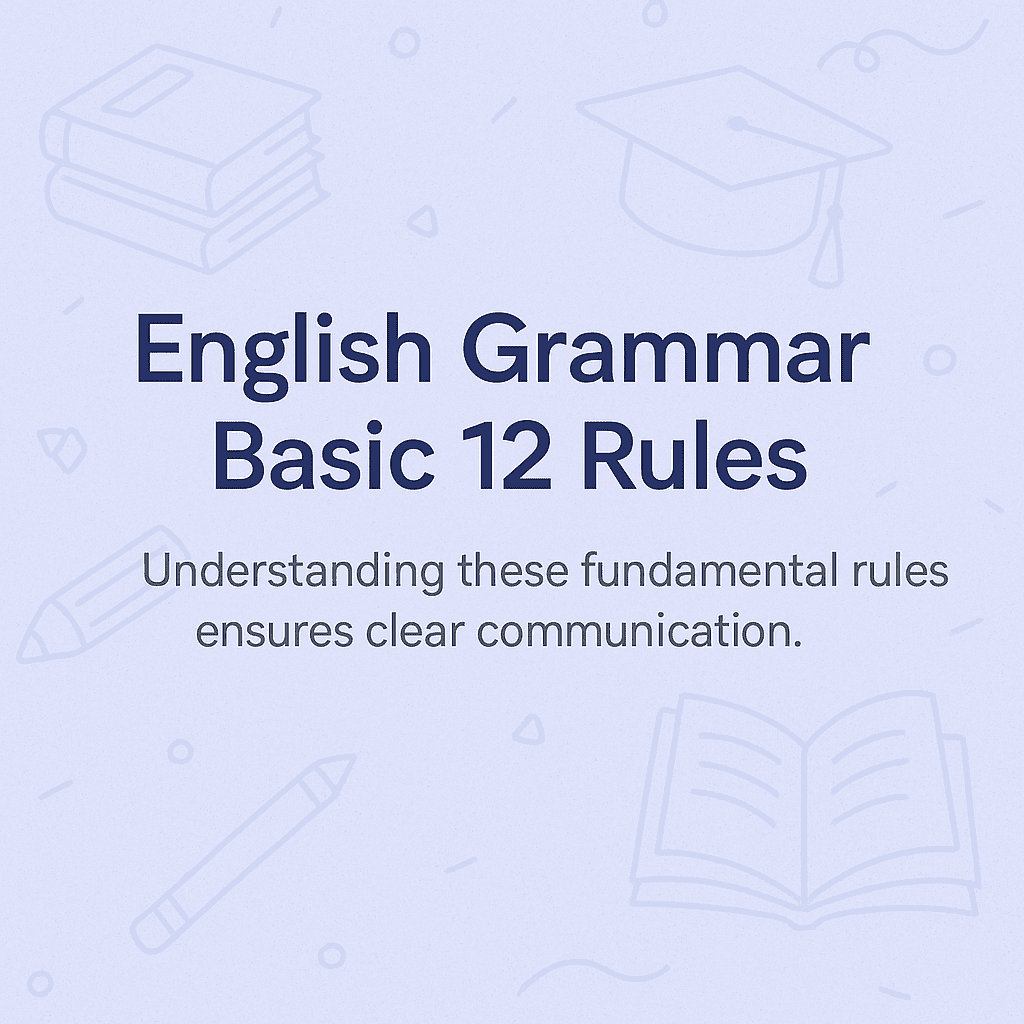English grammar provides a structured set of rules and guidelines that ensure the correct use and standard application of language. It supports both new learners and experienced users in maintaining accuracy and standard use.
We’ve assembled an extensive list of topics ranging from basic grammar to advanced grammar, arranged in a manageable succession. This guide, curated by our experts, allows experienced readers to check back on areas of necessity with ease.
English grammar may feel daunting, but mastering the basics is essential for clear communication. Whether you’re a student, professional, or language enthusiast, understanding these twelve fundamental rules will help you navigate the complexities of English with confidence and clarity.
Grammar is the structure of any language, made up of rules that govern how written and spoken words, groups, and sentences are arranged to make sense.
Why It is Important to Learn Complete English Grammar Rules
Complete English grammar is essential for effective communication and strong comprehension. It forms the foundation for building clear, concise, and accurate sentences in both writing and speaking. A strong understanding of grammar is crucial for achieving academic success, pursuing professional development, and improving overall language proficiency.
Rule 1: Subject-verb Agreement
A subject and verb in a sentence must agree in number. For example, a singular subject needs a singular verb: “She sings beautifully” is correct, while “She sing beautifully” is incorrect. When your subject is plural, match it with a plural verb: “They sing beautifully.” This consistency improves clarity and grammatical precision.
Rule 2: Use of Articles
Articles guide how we reference nouns. Use “a” before words that begin with a consonant sound (e.g., “a book”) and “an” for a vowel sound (“an apple”). When referring to something specific or mentioned before, use “the”: “Pass me the book on the table” or “I bought the book we talked about last week.”
Rule 3: Proper Use of Pronouns
Pronouns like he, she, it, and they must agree in gender and number with the nouns they replace. For instance, “He is going” is singular, while “They are going” is plural. Similarly, “She forgot her coat” vs. “They forgot their coats” reflects the same rule. Matching pronouns properly keeps your writing fluid and accurate.
Rule 4: Punctuate Your Sentences
Punctuation is essential for meaning and readability. Use commas to connect independent clauses, after introductory phrases, in a list, or to enclose non-essential information (a bracketing comma). Full stops, question marks, and exclamation marks all structure your sentences. Use apostrophes only for possessive nouns and contractions, not for plurals.
Rule 5: Use Capitalisation Correctly
Always capitalise proper nouns, the first word of a sentence, and titles to show importance and enhance clarity. When in doubt, resources like the blog series “Making Sense of Capitalisation” can help. Proper capitalisation makes your writing more professional and structured.
Rule 6: Sentence Structure and Using Complete Sentences
To construct clear, concise sentences, follow the subject-verb-object order and avoid run-on sentences or fragments. A subject might be I, he, she, you, we, they, it, or Jessica. The verb reflects what the subject is doing, such as eat, sleep, or run.
The object is the person or thing that receives the action—like in “He ate the bread.” Avoid run-ons that can be divided into two separate thoughts without adding, rearranging, or removing words. Proper punctuation helps prevent sentence fragments—for example, “Because of the rain” is incomplete. “My trip was cancelled because of the rain” uses both subject and main verb, making it a complete sentence.
Rule 7: Switch Word Order for Questions
Forming questions in English requires changing the usual word order. Typically, the auxiliary verb comes before the subject. So instead of “She is going shopping”, you ask, “Is she going shopping?” This rule is essential for clarity and tone when forming questions.
Rule 8: Use the Correct Verb Tenses
Use verb tenses that are appropriate to the action or event being described. Whether it occurred in the past, is happening in the present, or will happen in the future, make sure your tenses stay consistent. Don’t mix tenses within the same sentence, or it may confuse the reader. For example, if you begin in past tense, maintain that tense throughout unless there’s a reason to shift.
Rule 9: Use of Prepositions
Prepositions show relationships between words in a sentence, often indicating where or when something happens. Examples include in, on, at, and to. A preposition typically appears directly before the phrase it connects. In the sentence “They walked to the park,” the preposition “to” shows relation and direction. Using the right preposition enhances clarity and avoids confusion.
Rule 10: Use Conjunctions to Link Your Ideas
Conjunctions are powerful linking words that connect words and phrases into a complete sentence. You might’ve heard that you shouldn’t start a sentence with and, but, so, or because—but that’s a misconception. In modern usage, it’s perfectly acceptable, especially if your audience understands the tone and intent. These small words bring big structure and flow to your writing.
Rule 11: Avoid Double Negatives
Always avoid double negatives, as they create confusion and make sentences harder to understand. Use just one negative word per sentence. For example, “I don’t want no trouble” is incorrect, while “I don’t want any trouble” provides the needed clarity. This simple rule prevents your intentions from being misunderstood.
Rule 12: Active vs. Passive Voice
Using the active voice makes your writing more direct and engaging. In active constructions, the subject performs the action, which energizes your sentences. The passive voice, on the other hand, shifts focus to the receiver of the action and is best used when you want to emphasize that element. Both have their place—just use them wisely based on your message.

